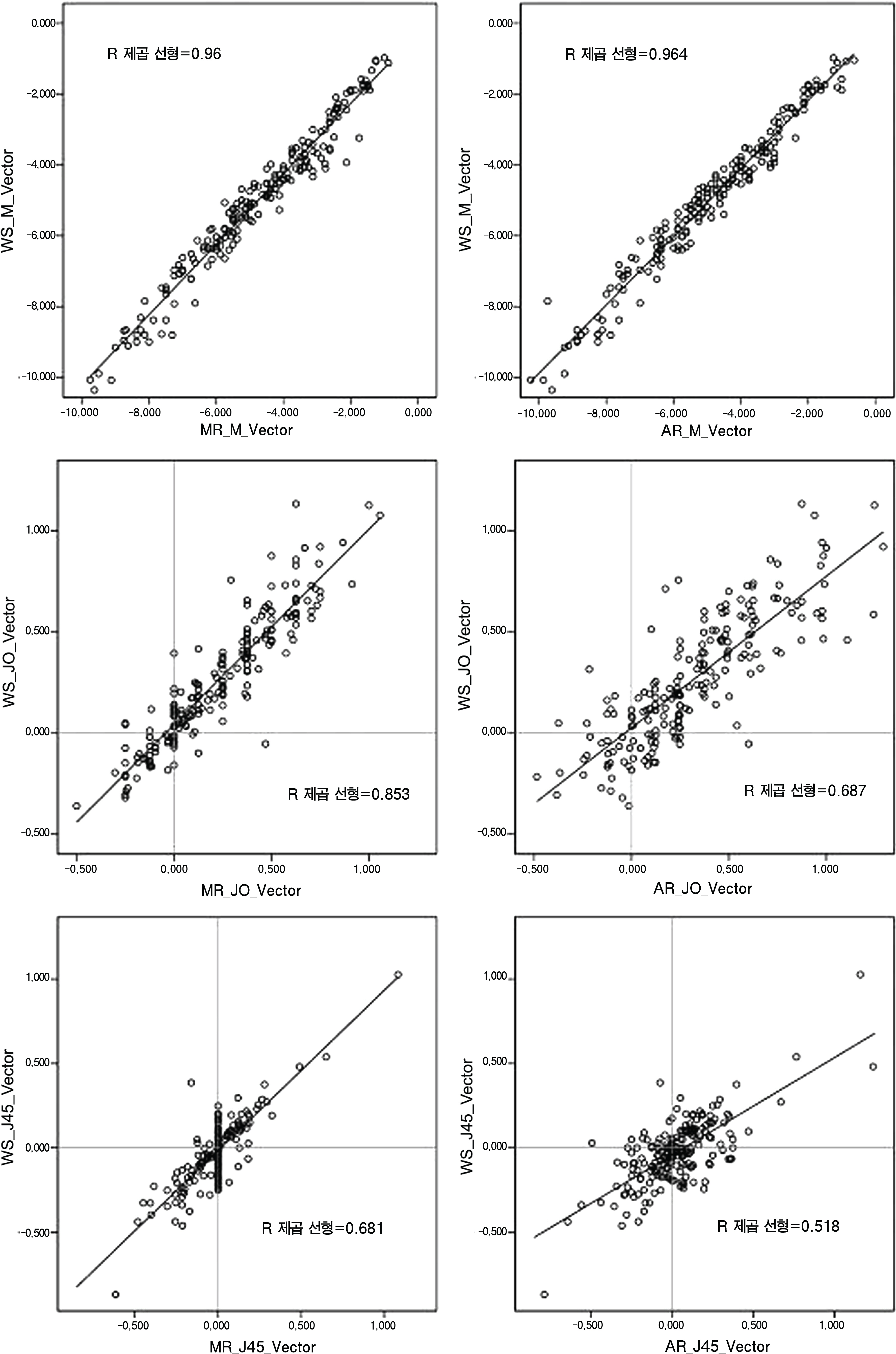J Korean Ophthalmol Soc.
2009 May;50(5):684-690. 10.3341/jkos.2009.50.5.684.
Comparison of WaveScan Aberrometer Refraction to Subjective Manifest Refraction and Autorefractor
- Affiliations
-
- 1Department of Ophthalmology, Seoul National University College of Medicine, Seoul, Korea. kmk9@snu.ac.kr
- 2Seoul Artificial Eye Center, Seoul National University Hospital Clinical Research Institute, Seoul, Korea.
- 3Department of Ophthalmology, Seoul National University Bundang Hospital, Sungnam, Korea.
- KMID: 2212298
- DOI: http://doi.org/10.3341/jkos.2009.50.5.684
Abstract
-
PURPOSE:To compare the accuracy of myopic refraction using an aberrometer (WaveScan, Visx, Santa Clara, CA, USA) with manifest refraction using retinoscopy and an autorefractor.
METHODS
The medical records of 200 eyes in 100 patients who visited our clinic from February 2005 to February 2007 for refractive surgery were reviewed retrospectively. We compared the refractive errors obtained using an aberrometer, retinoscopy, and an autorefractor (KR-7100, Topcon, Tokyo, Japan). All of the measured refractive errors were converted to power vectors for statistical analysis. The power vectors consisted of the M vector (M), J0 vector (J0), and J45 vector (J45).
RESULTS
The mean sphere was -4.75 diopters (D) and the mean cylinder was -0.66D with retinoscopy. Power vectors of the aberrometer (PVw) were highly correlated with power vectors of retinoscopy (PVr) and the autrorefractor (PVa). The correlation coefficients (R2) between PVw and PVr were 0.960 (M), 0.852 (J0), and 0.679 (J45) and the correlation coefficients between PVw and PVr were 0.963 (M), 0.685 (J0), and 0.516 (J45). Mean differences were -0.247+/-0.412D (M), 0.034+/-0.120D (J0), and -0.017+/-1.07D (J45) between PVw and PVr, and were -0.068+/-0.403D (M), -0.055+/-0.194D (J0), and -0.052+/-0.165D (J45) between PVw and PVa.
CONCLUSIONS
The measurement of refractive errors using a WaveScan aberrometer seems to be reliable and accurate, although some myopic shift was observed.
Keyword
MeSH Terms
Figure
Cited by 2 articles
-
Comparison of Optical Quality Between Two Intraocular Lenses Using Double-Pass Based Optical Quality Analysis System
Ae Young Kwak, Moonjung Choi, Kyoung Yul Seo, Ji Min Ahn
J Korean Ophthalmol Soc. 2013;54(12):1818-1823. doi: 10.3341/jkos.2013.54.12.1818.Comparison of Refractive Power and Astigmatism between Digital Keratometer and Autorefractor
Jae Won Choi, Sang Youp Han, Kyung Heon Lee
J Korean Ophthalmol Soc. 2017;58(1):21-26. doi: 10.3341/jkos.2017.58.1.21.
Reference
-
References
1. Charman WN. Wavefront Aberration of the Eye: A Review. Optom Vis Sci. 1991; 68:574–83.2. Wang J-Y, Silva DE. Wavefront interpretation with Zernike polynomials. Applied Optics. 1980; 19:1510–8.
Article3. Wang L, Wang N, Koch DD. Evaluation of refractive error measurements of the Wavescan Wavefront system and the Tracey Wavefront aberrometer. J Cataract Refract Surg. 2003; 29:970–9.
Article4. Reinstein DZ, Archer TJ, Couch D. Accuracy of the WASCA aberrometer refraction compared to manifest refraction in myopia. J Refract Surg. 2006; 22:268–74.
Article5. Cervino A, Hosking SL, Rai GK, et al. Wavefront analyzers induce instrument myopia. J Refract Surg. 2006; 22:795–803.
Article6. Jeong JH, Kim MJ, Tchah HW. Clinical Comparison of Laser Ray Tracing Aberrometer and Shack-Hartmann Aberrometer J Korean Ophthalmol Soc. 2006; 47:1911–9.7. Liang J, Grimm B, Goelz S, Bille JF. Objective measurement of wave aberrations of the human eye with the use of a Hartmann-Shack wavefront sensor. J Opt Soc Am A Opt Image Sci Vis. 1994; 11:1949–57.
Article8. Thibos LN, Horner D. Power vector analysis of the optical outcome of refractive surgery. J Cataract Refract Surg. 2001; 27:80–5.
Article9. Thibos LN, Wheeler W, Horner D. Power vectors: an application of Fourier analysis to the description and statistical analysis of refractive error. Optom Vis Sci. 1997; 74:367–75.
Article10. Kinge B, Midelfart A, Jacobsen G. Clinical evaluation of the Allergan Humphrey 500 autorefractor and the Nidek AR-1000 autorefractor. Br J Ophthalmol. 1996; 80:35–9.
Article11. Mallen EA, Wolffsohn JS, Gilmartin B, Tsujimura S. Clinical evaluation of the Shin-Nippon SRW-5000 autorefractor in adults. Ophthalmic Physiol Opt. 2001; 21:101–7.
Article12. Gwiazda J, Weber C. Comparison of spherical equivalent refraction and astigmatism measured with three different models of autorefractors. Optom Vis Sci. 2004; 81:56–61.
Article13. Elliott M, Simpson T, Richter D, Fonn D. Repeatability and accuracy of automated refraction: a comparison of the Nikon NRK-8000, the Nidek AR-1000, and subjective refraction. Optom Vis Sci. 1997; 74:434–8.
Article14. Chat SW, Edwards MH. Clinical evaluation of the Shin-Nippon SRW-5000 autorefractor in children. Ophthalmic Physiol Opt. 2001; 21:87–100.
Article15. Oh JR, Kim JS, Lee DH. The Change of Ocular Aberration after LASIK Surgery. J Korean Ophthalmol Soc. 2003; 44:278–83.16. Bland JM, Altman DG. Statistical methods for assessing agreement between two methods of clinical measurement. Lancet. 1986; 1:307–10.
Article17. Goss DA, Grosvenor T. Reliability of refraction–a literature review. J Am Optom Assoc. 1996; 67:619–30.18. Rosenfield M, Chiu NN. Repeatability of subjective and objective refraction. Optom Vis Sci. 1995; 72:577–9.
Article19. Nissman SA, Tractenberg RE, Saba CM, et al. Accuracy, repeatability, and clinical application of spherocylindrical automated refraction using time-based wavefront aberrometry measurements. Ophthalmology. 2006; 113:577.
Article
- Full Text Links
- Actions
-
Cited
- CITED
-
- Close
- Share
- Similar articles
-
- Comparison of the Refractive Error Measurement Using Different Methods in Wavefront-Guided LASEK
- Comparison of Manifest Refraction and Cycloplegic Refraction Using Retinoscopy or an Autorefractor in Children
- Usefulness of Refractive Measurement by Wavefront Aberrometer in Children
- Statistic Observation About Effect of Cycloplegic Refraction in Primary School Children
- A Study about the Accuracy of Automated Refraction


